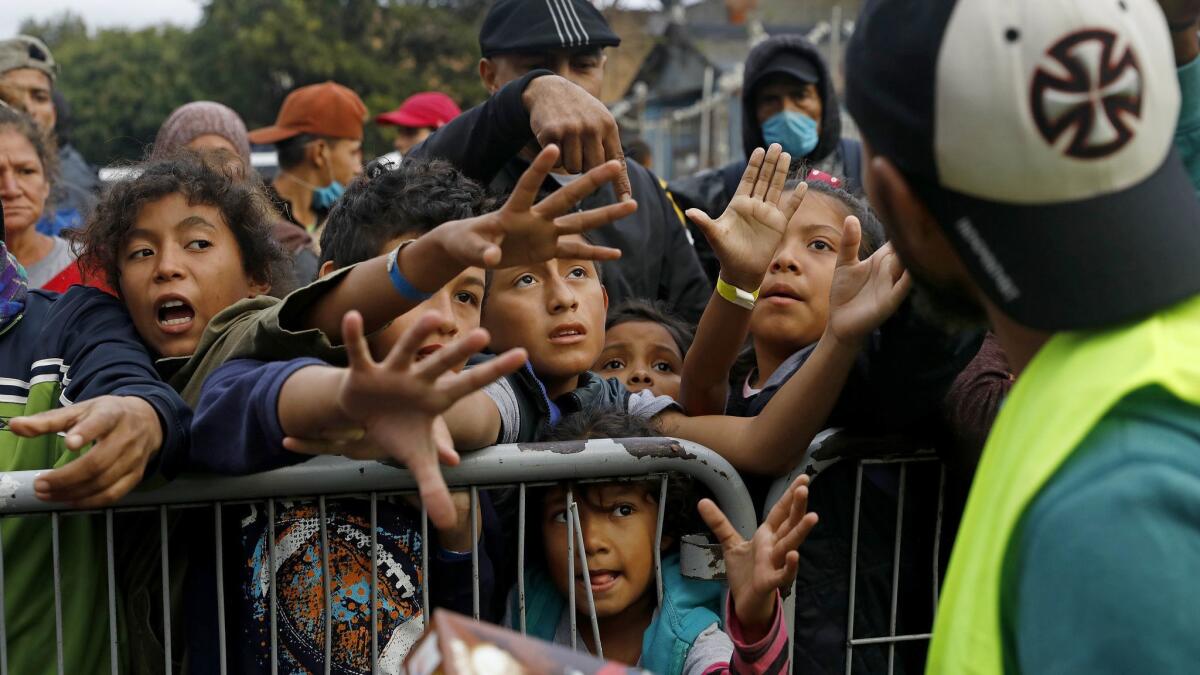Mexico is unprepared for the deal it made with the U.S. on asylum seekers, immigration chief says

- Share via
Reporting from Mexico City — Mexico is facing a prospective new influx of Central American asylum-seekers — possibly numbering in the tens of thousands — from the United States in coming months because of a new Trump administration crackdown on illegal immigration.
But Mexico’s top immigration official has said the country is not prepared to handle fresh waves of migrants facing months and possibly years of delay before the resolution of asylum petitions filed in the United States.
“We can’t receive them,” Tonatiuh Guillen, who heads Mexico’s National Migration Institute, told reporters Thursday. “We don’t have the capacity.”
He did not specify how long it would take for Mexico to be ready.
Under the new U.S. policy, unveiled Thursday in Washington, migrants filing for asylum along the Southwest border will be sent back to Mexico while their applications are reviewed, a process that can drag on for months or years.
The asylum applicants will be free to remain in Mexico on humanitarian visas and will be eligible for work permits while their cases are pending in U.S. immigration courts, the Mexican Foreign Ministry said.
“They will not be detained,” Alejandro Alday, a legal advisor for the Mexican Foreign Ministry, told reporters in Mexico City.
The asylum seekers returned to Mexico would not be forced to remain in northern border cities such as Tijuana — which has been scrambling to provide housing, food, medical services and other aid for thousands of Central America migrants who have arrived in recent caravans with the hope of crossing into the United States.
However, Mexican officials have not clarified whether those sent back to Mexico under the new U.S. policy would likewise be provided with shelter and other needs at government expense as they awaited the results of asylum claims.
“They will be in a dignified position in our country,” Alday said, adding that the returned migrants would arrive in “a situation of enormous vulnerability.”
Criminal gangs have long preyed on Central American migrants in Mexico. A pair of Honduran teens who traveled to the border as part of a recent caravan were slain in Tijuana last weekend in connection with what police called a robbery.
Some observers were already predicting that the policy shift would present substantial new burden for towns along Mexico’s northern frontier.
“Get ready for a humanitarian crisis on the border, more serious than the one that already exists,” Denise Dresser, a Mexico City-based political scientist and columnist, wrote in a Twitter message.
It is impossible to predict how many asylum seekers will be returned to Mexico under the new guidelines. Analysts said the new policy may dissuade some people from applying and cause others to abandon their U.S. cases rather than be stuck in Mexico for months or years.
In the most recent fiscal year, U.S. border authorities detained more than 90,000 foreigners, mostly Central Americans, who claimed “credible fear” of returning to their homelands, the first step in the asylum process. The Trump administration calls most of the claims bogus.
Shelters in Mexican border cities such as Tijuana, Ciudad Juarez and Matamoros are already mostly full, according to human rights advocates.
Even before Mexican President Andres Manuel Lopez Obrador took office on Dec. 1, his representatives have been in discussions about the matter with the Trump administration . How to deal with the migration crisis — and not be seen as caving in to U.S. demands — has been a major focus of the new government here. But both Mexico and the United States called the latest shift in asylum policy a unilateral move by Washington.
Lopez Obrador has sought to have an amicable relationship with Trump, who has threatened to close the border and cut aid to Central America if something was not done to stem the influx of U.S.-bound migrants traversing Mexican territory.
Staff writer Kate Linthicum and Cecilia Sanchez of The Times’ Mexico City bureau contributed to this article.
Twitter: @PmcdonnellLAT
More to Read
Sign up for Essential California
The most important California stories and recommendations in your inbox every morning.
You may occasionally receive promotional content from the Los Angeles Times.













